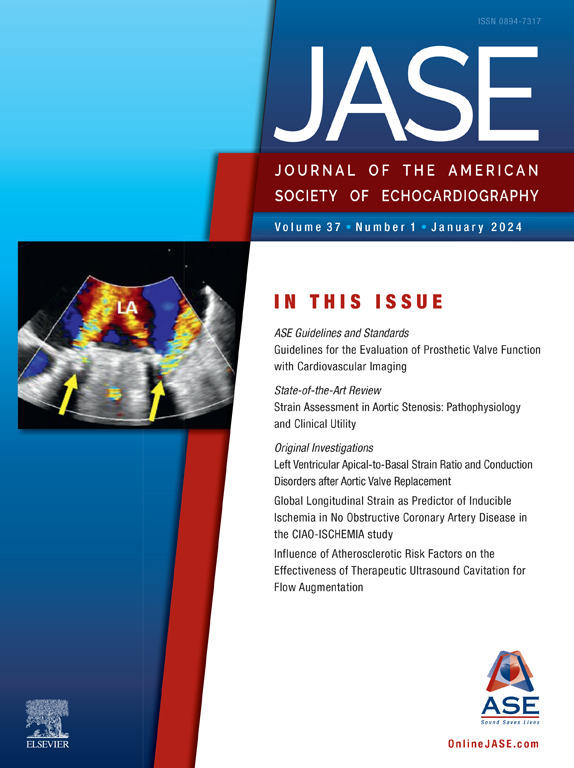超声心动图机器学习模型在重症监护病房患者预后预测中的应用。
IF 6
2区 医学
Q1 CARDIAC & CARDIOVASCULAR SYSTEMS
Journal of the American Society of Echocardiography
Pub Date : 2025-04-01
DOI:10.1016/j.echo.2024.11.014
引用次数: 0
摘要
在icu(心脏重症监护病房)入院时的风险分层是至关重要的,仍然具有挑战性。目的:我们旨在研究基于初始经胸超声心动图(TTE)的机器学习(ML)模型的准确性,以预测重症监护病房(icu)住院患者的院内主要不良事件(MAEs)。方法:本前瞻性多中心研究(39个中心)纳入了所有在入院前24小时内连续住院的重症监护病房完成TTE的患者。评估16个TTE参数。机器学习模型采用随机生存森林自动特征选择和XGBoost算法建立模型。主要终点为院内mae,定义为:全因死亡、复苏性心脏骤停、心源性休克。结果:在1499例连续患者(63±15岁,70%男性)中,有67例(4.5%)发生MAE。模型选取的5个TTE参数为:左室流出道速度-时间积分(LVOT - VTI)、E/ E′比值、收缩期肺动脉压(sPAP)、三尖瓣环面收缩偏移(TAPSE)、左室射血分数(LVEF)。使用XGBoost, ml模型的受试者工作曲线下面积(AUROC)高于任何现有评分(ml模型:0.83,logistic回归:0.76,acute - hf评分:0.66,timi评分:0.60,grace评分:0.58)。结论:与现有评分或ICCU临床和生物学数据相比,基于初始TTE的ml模型对院内MAE的预测价值更高。本文章由计算机程序翻译,如有差异,请以英文原文为准。
Utility of an Echocardiographic Machine Learning Model to Predict Outcomes in Intensive Cardiac Care Unit Patients
Introduction
The risk stratification at admission to the intensive cardiac care unit (ICCU) is crucial and remains challenging.
Objectives
We aimed to investigate the accuracy of a machine learning (ML)-model based on initial transthoracic echocardiography (TTE) to predict in-hospital major adverse events (MAEs) in a broad spectrum of patients admitted to ICCU.
Methods
All consecutive patients hospitalized in ICCUs with a complete TTE performed within the first 24 hours of admission were included in this prospective multicenter study (39 centers). Sixteen TTE parameters were evaluated. The ML model involved automated feature selection by random survival forest and model building with an extreme gradient boosting (XGBoost) algorithm. The primary outcome was in-hospital MAEs defined as all-cause death, resuscitated cardiac arrest, or cardiogenic shock.
Results
Of 1,499 consecutive patients (63 ± 15 years, 70% male), MAEs occurred in 67 patients (4.5%). The 5 TTE parameters selected in the model were left ventricular outflow tract velocity-time integral, E/e’ ratio, systolic pulmonary artery pressure, tricuspid annular plane systolic excursion, and left ventricular ejection fraction. Using the XGBoost, the ML model exhibited a higher area under the receiver operating curve compared with any existing scores (ML model, 0.83 vs logistic regression, 0.76, ACUTE-HF score:,0.66; thrombolysis in myocardial infarction score, 0.60; Global Registry of Acute Coronary Events score, 0.58, all P < .001). The ML model had an incremental prognostic value for predicting MAE over a traditional model including clinical and biological data (C index 0.80 vs 0.73, P = .012; chi-square 59.7 vs 32.4; P < .001).
Conclusion
The ML model based on initial TTE exhibited a higher prognostic value to predict in-hospital MAEs compared with existing scores or clinical and biological data in the ICCU.
求助全文
通过发布文献求助,成功后即可免费获取论文全文。
去求助
来源期刊
CiteScore
9.50
自引率
12.30%
发文量
257
审稿时长
66 days
期刊介绍:
The Journal of the American Society of Echocardiography(JASE) brings physicians and sonographers peer-reviewed original investigations and state-of-the-art review articles that cover conventional clinical applications of cardiovascular ultrasound, as well as newer techniques with emerging clinical applications. These include three-dimensional echocardiography, strain and strain rate methods for evaluating cardiac mechanics and interventional applications.

 求助内容:
求助内容: 应助结果提醒方式:
应助结果提醒方式:


